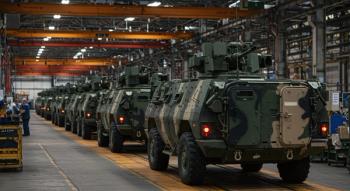
Wavelength Tech Forum: Optics/Lasers
Lasers and optics continue to comprise a thriving and emerging market in the field of spectroscopy, with new breakthroughs occurring at a rapid pace. Here to discuss the latest developments in these areas are Alexander Bolshakov, Applied Spectra; Phil Taday, TeraView; and Rob Morris, Ocean Optics, Inc.
Lasers and optics continue to comprise a thriving and emerging market in the field of spectroscopy, with new breakthroughs occurring at a rapid pace. Here to discuss the latest developments in these areas are Alexander Bolshakov, Applied Spectra; Phil Taday, TeraView; and Rob Morris, Ocean Optics, Inc.
What is the hottest trend you’ve seen in the area of optics and lasers recently?
Bolshakov: The most rapidly evolving field is the development and application of femtosecond lasers. Significantly higher precision and repetition rates, as well as superior eye safety offered by these devices relative to previous generations, have resulted in a burst of new applications, such as in ophthalmology (e.g., corneal reshaping, astigmatism correction, and glaucoma surgery), nano-processing of materials, lithography, fast-mapping LiDARs, and spectroscopy. Concurrent advances in semiconductor lasers and other electro-optical devices (including flexible organic electronics) continue to revolutionize the fields of telecommunication, computing, optical data storage, and nanotechnology.
Taday: The application of terahertz pulsed imaging to the area of art investigation. Museums around the world are looking for nondestructive and more importantly noncontract methods to analyze and investigate rare and high-value art works. These studies are investigatingstructures below the top layers on paints missed by conventionaltechniques such as X-ray and near infrared for differing reasons.From a scientific point-of-view, I find this an exciting interesting areato be involved.
Morris: There is increasing interest in exploring ways to improve spectral imaging technologies through the use of more sophisticated optics. In particular, hyperspectral imaging, a relatively complex technique that generates excellent data for a number of applications, but requires great effort to manage, will benefit from the emergence of technologies such as dichroic filter arrays that provide a simpler, more convenient (and potentially less expensive) route to the same results.
What application areas will benefit most from advances in laser and optics technology?
Bolshakov: Analytical instrumentation has benefited from improvements in reliability and performance of lasers. In spectroscopy, femtosecond lasers (generally, ultrafast lasers) have enabled new approaches. Since the laser pulse can be shorter than the molecular dynamics, a new domain of intramolecular studies has arisen. Now it is practical to break only particular bonds but leave the others intact, even those that are very weak. Temporal shaping (tailoring) of laser pulses facilitates the coherent movement of molecules, thus multiplying their collective response. One can generate coherent phonons to use them for intense stimulated Raman scattering. One can play a similar trick with atoms to exploit their enhanced emission. The latter may aide in achieving nano-sized resolution in LIBS measurement.
Taday: With the drive to get lasers smaller — this is the limiting form factor in most instruments — nondestructive testing in hostile production environments becomes more attractive.
Morris: Ultrafast science — very short-duration, high-energy lasers, in particular — certainly has application in physics research and materials analysis. Smaller, faster, and more powerful lasers make possible applications where system footprint and power-supply considerations impose limitations today.
Has the trend toward miniaturization and portability had a great impact on the fields of lasers and/or optics?
Bolshakov: As a result of this trend, a market share of miniature and handheld analytical instruments is rapidly growing. Today’s leading techniques in handheld instrumentation are XRF, Raman, FT-IR, NIR, and UV-vis, while LIBS is gaining ground. Truly miniature electro-optical, electro-chemical sensors, and nanosensors continue to emerge. All these developments stimulate further miniaturization of lasers, spectrometers, and other components.
Morris: Absolutely. Think of the interest in lasers and ultrafast science applications. Or consider the desire to take a powerful laboratory elemental analysis technique such as LIBS (laser-induced breakdown spectroscopy), where the laser is such a critical element of the science, and make it portable for applications such as chemical and biological warfare agent detection. That’s just one example among many applications.
How has the market for lasers and optics fared during the recent recession?
Bolshakov: Last year laser sales declined for the first time in 17 years. However the scientific, analytical, spectroscopic, and clinical segments of laser market fared relatively well. There have been some cutbacks in instrumentation, but the government financial stimulus has provided great funding to enhance this infrastructure.
Taday: We see the academic market doing quite well at the moment. But as governments begin to deal with very large budget deficits, the academic market may start to recede as governments start to put pressure on public spending, so things may start to get harder. Of course this will vary from country to country — and in the UK may even depend on the color of the party in power! Industry itself has receded over the last year but we arebeginning to see an increase from various market sectors. Hopefully,we will not see the forecasted "W" recovery over the next 12 months.
Morris: I don’t have hard numbers to back this up, but anecdotal evidence suggests that technologies supporting disciplines such as biomedical diagnostics and life sciences have been less prone to ups and downs in the economy. Lasers (especially) and optics seem to fit that bill.In general, however, although the market is decidedly more optimistic than it was at this time last year, caution appears to be the order of the day.
What trends do you see emerging in the next 5-10 years in the area of lasers and optics?
Bolshakov: Over past 50 years, lasers have found applications in areas that people would not have imagined. They will certainty become even more accepted in industrial, medical, and household settings because of their reliability, safety, and performance benefits. Optoelectronics, perhaps, will bring us holographic TV sets that we can carry along with us in the form of a flexible thin screen rolled into a tube for convenience.
Morris: In optics, there are very exciting developments in the area of producing single-wavelength sensors, where it will be possible to reduce sensing system size and cost without sacrificing performance. Such systems are already on the market, but our sense is they’ll become more sophisticated in what they can do and more convenient in how they do it.
What do you think?
If you are interested in participating in any upcoming Technology Forums please contact Editor-in-Chief
Newsletter
Get essential updates on the latest spectroscopy technologies, regulatory standards, and best practices—subscribe today to Spectroscopy.




